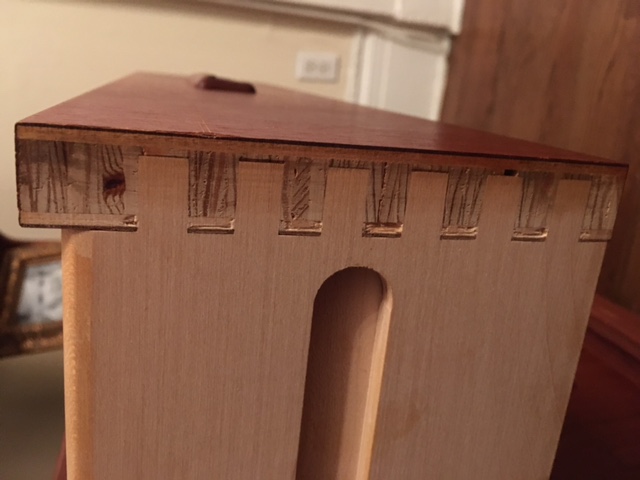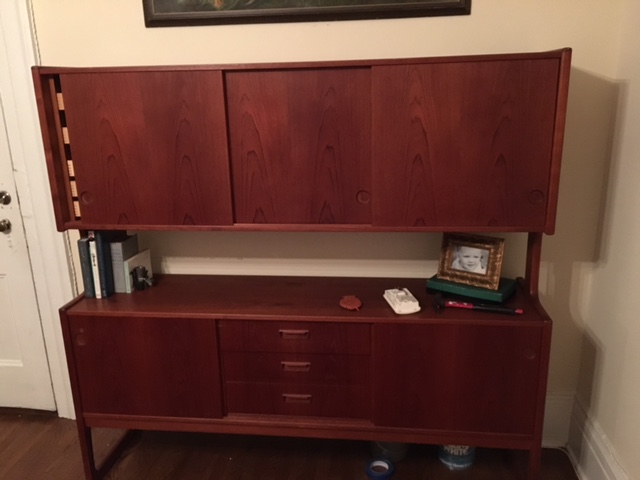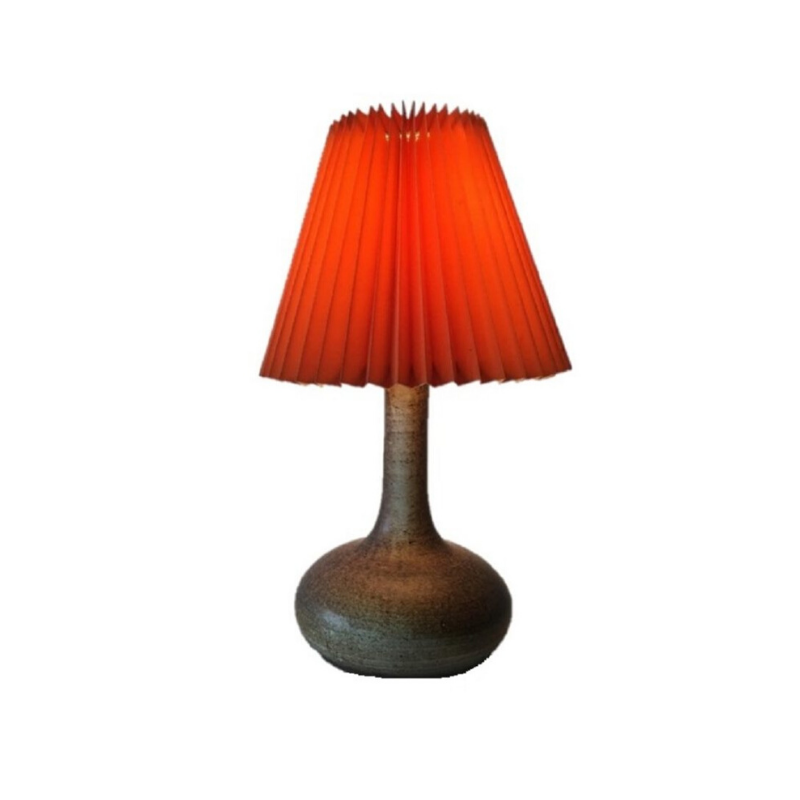This piece is beautiful, really well-made, and unmarked!
The side pieces are made of about a gazillion dollars worth of solid teak. Very nicely constructed, lovely circular pulls.
The only marking is from the retailer: "Spivack Living Furniture. Leo H. Spivack, New York." (He imported Danish furniture from Randers at the very least, according to other marked pieces online.)
Does anyone have any clues? <img class="wpforo-default-ima
<img class="wpforo-default-ima
Nice piece!
Leo Spivack was indeed an importer based in New York. I'n the couple of ads of his I've seen there is a wide range of Scandinavian stuff, Danish and Norwegian. So I don't think you are going to have a lot of luck narrowing it down like that.
And the sides are very unlikely to be solid teak through and through. The center strip will be, but beyond that not. The wood movement, were it solid teak would cause problems for the bottom "sleigh runner" foot, and for the cases. Were it solid teak all the way across, the cases would have to be mounted such that they can slide as the sides expand and contract, and the legs would have to be made thinner such that they would flex with the movement.
Photos of the drawer sides, and insides would help.
Interesting. I see end grain on the sides, and I've only ever seen faked end grain once in a danish piece. You are absolutely right.
Perhaps it disassembles like Wegner's RY 20, and the top and bottom cases are only fixed to the sides at the front. Thus the sides can expand and contract, while the tops and bottoms of the cases do not, as they are veneer over something.
And I guess the legs provide enough flex that the joints holding the sleigh runner feet on have not broken.
It appears to have been intended to be a fairly valuable piece of craftsmanship.
Oh, and I like how they put a piece of solid teak inside the edges of the bypass doors, so that they could cut the round handles through the door veneer and into that solid strip.
I would be curious to see photos of the disassembly. Here is how the RY-20 comes apart:
http://www.thomaspenrose.com/diy_RYmobler01.htm
The side pieces come right off: pegs and nice sturdy brass screws. There are screws both front and back though. The cases are then separate, and the sliding doors can only be removed when it's disassembled (unlike other cases where you can lift the doors out of their tracks.)
The original home it came out of (where it had been its whole life) was in a seaside town on Cape Cod in the woods. The house was very damp. The wood on all the pieces I got there had swollen a bit: it was really hard to get the screws out the first time! But indeed, those side pieces are full-on solid teak. They're heavy as hell.
We have the Wegner version, as well (with glass door top). The way it goes together is the same. Its so similar its weird.
There must be some way they worked around the wood movement then: slotted holes for the rear screws, or perhaps the front and rear screws are fairly close (6" - 8"), but there must be something.
What does the joint between the solid teak board look like at the end grain? Different companies used different profiled router bits. Might help narrow it down.
I have this same piece, also located in Mass, I know one other person in New England that has it, and you might have his...I have seen it on designaddict but no one was able to identify it. I have also seen it for sale online at a shop in the midwest, or Arizona... possibly.
Has a few factory numbers and scribbles on the inside, but nothing legible.
Was told it came from a retailer in Cambridge,MA in the 70's but I forget who.
The only solid teak parts are the legs,thick edge banding, and possibly the sections running through the top and bottom of the case, everything else is veneer over hardwood.
I spent hours looking for a designer and came to the conclusion it was designed by G. Tibergaard Nielsen.
I know it is poor judgement, but the drawer pulls are identical to those found on his desks/secretary. Not sure about the drawer pulls you have.
Id be delighted if you could prove me wrong.


I'm not 100% sure where the end grain is shown in stacyneil's photo.
It is very hard to see where the edge banding and veneer meet but I can tell you with 99% certainty it is not solid, everything is book matched.
The doors, sides etc. I dont think stacyneils is solid either. The two pieces are identical other than the drawer pulls.
I have attached a few more photos that may or may not help. you can see in the last photo where the edge banding of the door and veneer meet, the two shades can be seen. There is a tongue and groove joint where a solid T- shaped piece of teak (tongue) meets the (grooved) veneer over hardwood door.
Edit: I would say the construction is probably the same as the RY-20. The only solid portion being the side rails/legs


Post #3 photo #6 shows the end grain on the top edge of the side piece of staceyniel's specimen.
Post #10 photos #1 and #2 show side grain (edge banding) in the same location, and wood that is visibly veneer next to the edge banding.
Surprising difference. The veneered version is a much safer alternative for the cabinetmaker, as a slab of teak that wide can move a lot, and cause all sorts of problems.
And I don't think that these double sideboards are made by the same company as the Tibergaard Nielsen secretary you posted. Even though the identical handles are suggestive, when you look at the side of a drawer you see a whole different construction. Here is the side of a drawer.
http://www.lauritz.com/Item/ItemImage/ItemImagePage.aspx?LanguageId=4&It...
Note the drawer front is made from birch plywood, the drawer slide passes to the drawer front, and the drawer sides are a dark secondary wood. Compare that to the lumbercore drawer front, stopped dado drawer slide, and light wood drawer sides.
Well this is all really fascinating!!!
Here are some additional detail pics of the end pieces, if this helps.
Regarding the fasteners, I think they are about 8-10" apart (closer in the upper case). 4 per case side. The brass screws fit into brass threaded inserts in the side pieces.
Also, I believe this piece was from the 60s, although I'm not 100% sure. But it was new when the house was built, and the house looked more 60s than 70s to me. I could be wrong about that, though!


Staceyneil: Can you post a photo of the front corner of the side piece? I think there is a separate piece of teak there, but I can't quite tell.
Here's what I can tell tell from these photos. There is veneer over the entire surface of the side face. I can see this in the grain pattern. The easiest way to notice this is that the grain pattern is a book match mirrored down the center because the veneer is sequential flitches. The second thing to note is that there is no joint in the side grain that matches the joint in the end grain.
So the maker is hiding something under that veneer. What that is really depends on the age of the piece. If it is early to mid 60s on, then it is probably particle board with a strip of pine up the center. If it is earlier, then it is probably one piece of lumbercore cut to shape. Either would have been surrounded by edge banding. And in this case the oddity is that there is a bit of end grain edge banding. (This is the second time I've ever seen that).
My guess, based on the fact that the side pieces are notably heavy is that it is particle board underneath the veneer. Solid teak is lighter than particle board, by volume. And solid lumbercore is lighter still. Also, end grain edge banding strikes me as "later".
If you want to find out, you could unscrew on of the threaded inserts. The hole should be big enough to see particle board or lumbercore.
I will take one of the side pieces off and get more detailed photos tonight. This ID has been irking me for years now, I don't think we will get a positive ID without a stamped piece or advertisement. It looks like there were remnants of a tag on the bottom of mine. Stacey, Can you take a picture of the Leo Spivack tag?
I agree that the drawer construction is very different on both pieces, I never looked that far into the Tibergaard piece, thanks Leif!
If you need any help, please contact us at – info@designaddict.com











